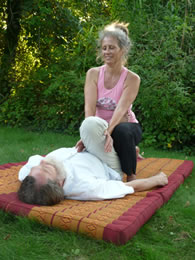 Traditional Thai massage is a different form of tissue manipulation than we usually associate with the word massage. It combines elements of yoga, meditation, acupressure, and assisted stretching to provide a unique and wonderful experience of bodywork. In recent years Traditional Thai massage has undergone a resurgence of popularity in Thailand and Asia. From there it spread to the West. Today, it is practiced in clinics, spas, and private practices all over the world.
Traditional Thai massage is a different form of tissue manipulation than we usually associate with the word massage. It combines elements of yoga, meditation, acupressure, and assisted stretching to provide a unique and wonderful experience of bodywork. In recent years Traditional Thai massage has undergone a resurgence of popularity in Thailand and Asia. From there it spread to the West. Today, it is practiced in clinics, spas, and private practices all over the world.
Like Brennan Healing Science, Bhakti Massage, and Kundalini Yoga, Traditional Thai bodywork has a holistic or integrated approach. A balanced flow of energy plays a central role in its concept as it focuses on helping to attain or regain the balance of energy. This energy travels along Sen lines, comparable to the meridians of Chinese Medicine and Prana along the Nadis in the Indian tradition. By positively influencing the energy flow the recipient can let go of holding patterns on the physical, emotional, and mental levels.
Physically, this massage approach works on both the superficial and deeper fascial layers of muscles, ligaments, joints, and connective tissue, and it touches all areas of the body including the nervous, digestive, and respiratory system.
How does Traditional Thai massage differ from other massage styles?
- Thai bodywork is practiced with the client fully dressed in loose fitting clothes, preferably made of natural fibers.
- No lubricants or oils are used.
- The massage is practiced very slowly.
- The practice emphasizes pressing, compression, and stretching techniques. The rubbing techniques of Western massage like euffleurage and petrissage are absent.
- In addition to their hands and fingers practitioners utilize their knees, feet, elbows and forearms during the treatment.
- Traditionally, sessions take place on a cotton pad or Thai rubber mat that is placed on the floor.
- Therapists are encouraged to work in a concentrated and meditative state of mind, free of inner “chatting”. They are supposed to transmit this quality of mind through their touch to their client.
- Although it is the physical body that is addressed in the massage, the primary focus and intention of the therapy is to bring harmony and balance to the energetic body and mind of the recipient.
Who can benefit from a Traditional Thai Massage and how?
This massage style can benefit most people regardless of age or flexibility. It can be adapted to suit most conditions and circumstances. Many common ailments respond well to Thai bodywork and it is very effective for maintaining a high level of health and well being.
What does a Thai Massage session look like?
Due to the nature of a traditional massage in the Thai style, treatments last generally 2 hours for best results. However, I also offer 90 minute and 1hour sessions to make it more accessible and give clients a taste.
Each treatment will be tailored according to individual considerations and any condition being treated. In each session all areas of the body are worked on as well as the Sen line system. Positions include face up, face down, side-lying and seated.
The benefits of Traditional Thai massage:
- Thai bodywork increases flexibility and joint mobility.
- Neck and shoulder pain and related headaches are released.
- Recipients naturally relieve many other forms of stiffness.
- The massage is aiding in range of movement and opening up the body after illness, an accident or long periods of sedentary.
- It improves circulation and the lymph flow.
- Detoxification is accelerated.
- Thai bodywork induces deep relaxation to counter stress, anxiety, and other related problems.
- Recipients release deeply held physical, mental, and emotional tension and related energy blockages.
- Massage in the traditional Thai style is cultivating body / mind awareness and integration.
- As a form of positive health maintenance it boosts energy levels, vitality, and immunity.
The History of Thai massage
 In Thailand, Thai bodywork is known as Nuad Bo’Rarn. Nuad translates as
In Thailand, Thai bodywork is known as Nuad Bo’Rarn. Nuad translates as “to touch with the intention of imparting healing”
. Bo’Rarn derived from Sanskrit and can be translated as “something, which is ancient and revered”
. The same word Bo’Rarn is also applied to the sutras (texts) of Buddhism.
Traditional Thai bodywork is an ancient healing art that originated in India, with its roots in Hatha Yoga and Ayurvedic medicine. With traveling Buddhist monks it made its way to what is today known as Thailand, around the 3rd or 2nd century BC. Here, it also incorporated theories and practices from ancient China, as well as healing practices of indigenous tribes of the area. Over the centuries the hands on healing methods of what is today known as Thai massage has become an integral part of the holistic approach of Thai medicine, which includes
- Herbal Medicine,
- Nutrition and diets,
- Spiritual practices (meditation, mantras, prayer, incantations),
- Massage.
Thai bodywork techniques were applied to a wide variety of ailments, including mental and emotional illness. Traditionally, Thai medicine was the knowledge of Buddhist monks and, to a lesser extent, nuns. For centuries this knowledge was transmitted orally from practitioner to student.